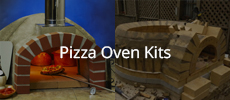Thanks so much for your help!
Yes, my description was not quite detailed enough. I was actually going to cast the flue gallery at the same time I cast the actual dome, following Nick J C fabulously detailed record of his oven. I was just trying to visualize what the layers were so that I could better calculate volume.
Two more questions:
1) I looked at a few more photos of people's ovens, and it may not be that hard to cut the bricks in an acceptable circle and cast the dome around it instead of on top. I may try that anyway. Any slight out of circle areas could also be filled with Homebrew. Any reason why that would be a bad idea and why you are suggesting vermicrete to even out the edges? Is it because of expansion of the bricks?
2) If 10:1 vermicrete has approximately the same insulation value as a blanket, what is the advantage of using a ceramic fiber blanket? I have read that it helps to avoid cracking, since it allows for expansion of the cast dome.
Announcement
Collapse
No announcement yet.
Homebrew 3:1:1:1 - How to work out how much material to buy?
Collapse
X
-
Your major flaw is that you will need to cast a flue gallery between step 3 and 4.
Depending on how rough the perimeter firebricks are cut, you could do that layer that surrounds the floor bricks with vermicrete to accomodate any unevenness of the brick edges. A 10:1 vermicrete has approximately the same insulation value as blanket so don't make it richer or you'll reduce its insulating capacity.
Leave a comment:
-
david s , looked a bit further into what you had suggested. Before I update the spreadsheet, here is a quick sketch of what I have in mind for the dome construction / layers. The numbers indicate the order in which I would cast or install the parts.
1) cast vermicrete base 100mm thick. I may cast that a bit smaller than the total expected size of the dome + ceramic blanket + vermicrete, since I can always add when I add the vermicrete dome insulation layer
2) install firebrick on a thin layer of sand to get them level and to be able to remove at least the center ones
3) cast the dome. I was considering to cast the dome around the firebrick, but that would require that I cut the fire brick nicely into a circle, which I think is not that easy or at least a lot of work. I will cast the dome onto the firebrick, making the outer layer of firebrick non-removable
4) install the ceramic insulation blanket. It will go all the way down along the firebrick. I was considering to fill up with vermicrete to the level of the fire brick instead. Is there any reason to prefer one or the other?
5) cast a layer of vermicrete as the final insulation layer.
Then finish with stucco, which I have not drawn.
Let me know if you think this makes sense or if there are any major flaws. I can use this to update the spreadsheet.
Leave a comment:
-
Thanks, David,
I will take another look at this and see how I can update the spreadsheet.
Yes, I used 4 π r2 /2 for the area and
(4/3) π r3 /2 for the volume for all calculations, so that should be OK now.
Leave a comment:
-
Thanks for this task.
Regarding the density of vermiculite and perlite, I would imagine there will be some difference between manufacturers. I use a medium grade for both and they usually weigh around 10kg/100 litre bag which is 100kg/m3. Although in really humid weather they can be about 20% more. Maybe even more than that if they've been rained on.
Although you might calculate a required volume for both blanket and vermiculite on the basis of a hemisphere, from the top of the floor, extra is required to cover the floor bricks and the insulating slab. This may also vary depending on whether the builder forms the dome own top of the floor or around the floor. Hence my comment in post#37
https://community.fornobravo.com/for...046#post424046
area of a sphere = 4 π r2 (halve the result for a hemisphere)
volume of a sphere = (4/3) π r3 (halve the result for a hemisphere)
the missing area or volume at the oven mouth is usually about equivalent to the area or volume that surrounds the mouth so just work on the area or volume of a hemisphere without any opening.
Dimensions asked for dome and gallery diameters should be marked "(internal)"Last edited by david s; 07-19-2021, 04:06 AM.
Leave a comment:
-
EVERYBODY, I ONLY Updated the METRIC version of the spreadsheet, don't expect the IMPERIAL version to work!
Robarb Thanks a lot for updating the spreadsheet. And of course thanks to 4stroker, for creating this spreadsheet in the first place!
However, I think there are a few mistakes in your formulas. OR I may have made a mistake!
Here is what I did:- Added a formula for the base area of the dome and entrance, seems that that formula was missing.
- Entered the densities from the previous version. Can anybody (maybe david s )confirm that the vermiculite density is correct? I got it from https://www.vermiculite.org/wp-conte...lite_Data1.pdf and simply used the average of 64 and 160 kg/m3
- I made all the changes to the “metric” version. I am in Los Angeles, but it was easier to do the calculations in metric units, and look at the imperial equivalents in the column to the right of it.
- I think there may be some errors in the formulas (or I may have messed it up!). I would be very happy for somebody to check my work!
- Blanket insulation surface area – area formula used was 2*Pi*d^2*2, the area of a complete sphere is Pi*d^2. For the half sphere it should be ½ Pi d^2 or 2*Pi*r^2. I updated the formula
- Split the blanket insulation surface area into dome and gallery, then added them up. Not sure if I really need that much insulation, since where the gallery connects to the dome, there will not be any insulation. I am planning on looking at this if the area required is just a bit more than what I can order as standard size.
- Total dry volume – seems to be too large. Volume formula used is 2/3*Pi*d^3, but volume of a complete sphere is 1/6*Pi*d^3, and we have a half sphere, so 1/12*pi*d^3. I updated the formula.
- Not sure how the formula for the firebrick works. It seems that I can’t just take the area, since there will be quite some waste when cutting the round shape out of the fire bricks. Looked at the formula, but don’t understand the different parts of the formula.
- The formula is:
- (Area of the base + (230*114(this is area of one brick)))/26220 (this is the area of a brick) * 1.2 (is this a factor to account for cut bricks?) +5 (for the gallery, would give an gallery width of 570 and length of 230 I think).
- I updated the formula to reference the width (= 2x height) and depth of the gallery entrance. The formula seemed to have the size of the gallery entrance hardcoded.
- Not sure about the comment that it assumes 100mm Vermicrete, since the cell for the insulation thickness is referenced in the formula. I updated the heading of the section accordingly.
- Added a summary section that adds up all the materials so it is easier to see what I would need to purchase for this oven. I ONLY did this for the version that uses a ceramic blanket and NO CaSi board, since that is what I am planning on building.
- I added a section that calculates the finished size of the oven. It needs some updating, since I assumed that the depth is the diameter of the dome (+insulation, etc.) + the depth of the gallery. That of course is not correct, since the gallery sort of sticks into the dome.
Again, PLEASE review and feel free to correct any errors!
- Likes 1
Leave a comment:
-
Appreciate all the work done in the file. But I think the result for vermiculite of 760 liters is incorrect for 80cm inner-dome. Could it be 76 liters instead and just a typo in the formula?
Leave a comment:
-
Fo you think the figures for vermiculite usage is coming out right? Seems i little on the high side, especially if not using a fire blanket. However, i remember you saying people underestimate how much v.lite is actually used.
Leave a comment:
-
Thanks Robard, that looks pretty good although it may be overly prescriptive and assumptions about thickness of various layers will vary for self builders, but it should be useful. ThanksOriginally posted by Robarb View PostHello all,
I've slightly modified the original calculator and built a UK/US conversion into it. I haven't quite finished but i think i would like to check the Vermiculite/Vermicrete densities before i do.
david s , when you have a few spare moments are you OK to have a look and let me know what you think?
Thanks
P.s. thanks to 4stroker who lay the good groundwork
Leave a comment:
-
Hello all,
I've slightly modified the original calculator and built a UK/US conversion into it. I haven't quite finished but i think i would like to check the Vermiculite/Vermicrete densities before i do.
david s , when you have a few spare moments are you OK to have a look and let me know what you think?
Thanks
P.s. thanks to 4stroker who lay the good groundwork
- Likes 2
Leave a comment:
-
About 20%. This is why lots of 1st time builders run out of vermiculite. If you take the volume of vermiculite you use in the mix and add the cement and water, they do not add volume to the mix because they sit in the spaces between the grains of the vermiculite. On mixing the water acts to attract the solid particles together resulting in volume reduction. Best to mix it in a barrow so you can fold the mix gently. If mixed for too long in a mixer it begins to abrade the grains which leads to further reduction in volume. The right amount of water is when it just begins to pool a little in the bottom of the barrow. Usually 3 parts water for every 10 parts vermiculite.The finer the grade the more water is required.Last edited by david s; 06-13-2020, 01:25 PM.
Leave a comment:
-
Thanks david s
From your experience, what would you say the dry volume of an 8:1 vermicrete mix is, compared as to when wet and ready to be moulded/set? How much reduction in volume is there when mixed with water?
I'm adding to Mark's calculator, calculations for a vermicrete insulation layer, and base insulation layer too if i can. It's the last thing i would like to do then i can share here.
Leave a comment:
-
Not really with you, but the finer materials like clay and cement fill the spaces between the coarser material (sand) so resulting volume is less than the sum of the individual volumes of ingredients. Same goes for the water. On mixing the water in there is also some compaction which also reduces the volume. Is that what you mean?
In practice the sand is rarely completely dry although for the measurements I did use dry sand. Also density, depending on sand type can vary considerably and probably likewise for the powdered clay. Humidity also plays a part. You just need to add sufficient water to get the mix to a good workable “ball up” state. So don’t go by the water content in my measurements.
I do recall there was a shortfall of around 50 g when working out with the densities and put it down to material left behind in the barrow and on mixing tools as well as some evaporation during mixing.
Also the volume measurements were pretty rough, using a kitchen jug so could be out by at least a few%Last edited by david s; 06-13-2020, 05:45 AM.
Leave a comment:
-
Hi 4stroker and david s thanks for your time in putting this together.
I'm just making a few modifcations for info i've come across and for our fellows across the pond and wondered if i could ask something in relation to Note 1, points A and B.
If you have a volume of 1800ml of 4 things prior to dry mixing, and a net volume of those 4 things as c. 1350ml after dry mixing, your net volume is 1350ml. So, when calculating approx water input of 400ml to further reduce the volume to c.1260ml, you're essentially adding the water to the mix (1350ml), not the components (1800ml) separately.
In your excel sheet you work out the 'Approx. total volume of water required' as 'The total dry volume of materials required' (1800ml) * addition of water (400ml) = 0.2222
Should it not be 'Approx. total volume of water required' as 'Resultant volume of materials required' (1350ml) * addition of water (400ml) = 0.2963?
This would in theory make your final density reduction calculation as 'final volume after water addition' (1260ml) / initial dry resultant volume (1350ml) = 0.9333 (not the 0.7 you have in the spread sheet)
I know this is probably minuscule in the calcs but want to make sure i'm thinking correctly.
I hope that's clear as .... clay.
Thanks
Leave a comment:





Leave a comment: